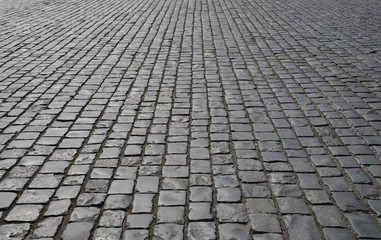Pavement is a complex system of layers built over natural ground to support vehicle loads. Pavement is often created and maintained to improve its performance, but the characteristics that make up a sustainable pavement vary.

Smooth pavements reduce wear and tear on vehicles, which saves money. They also increase pavement lifespan and require less maintenance.
A paved surface offers protection against the elements. Unpaved areas are highly vulnerable to damage which is costly and hard to repair. Pavement protects the underlying soil, reduces noise and helps to improve stability of vehicles. It is also easy to clean. It is important to perform regular maintenance to keep the pavement in a good condition and prevent damage.
Pavement structure is an integrated system of processes, materials and structures that serve to distribute vehicular loads over the natural soil sub-grade. The structure should be able to provide acceptable riding quality, skid resistance and light reflective properties, at the same time as allowing for drainage of water and other materials.
The paving materials used in highways have a wide range of applications in other types of pavements. These include surface treatments for pedestrians and cyclists, hazard warning surfaces and surfacing for kerb edges, road crossings and gradient changes.
Asphalt concrete (AC) and Portland cement concrete (PCC) are susceptible to corrosion from environmental factors including salts, chemical deicers, UV radiation, temperature variations, frost heave and surface erosion. Effective design, construction and sustainment of AC and PCC pavements minimizes these effects and extends the service life of the infrastructure facility.
Generally, corrosion impacts the structural integrity of the pavement structure, leading to distresses such as cracking, spalling and pothole formation. To mitigate corrosion, pavement structures must be constructed and maintained to meet or exceed minimum design standards.
Maintenance includes routine cleaning of the paved area to remove debris and dirt that is blocking drainages and causing pooling water. In addition to this, a seal coat every 24 to 36 months can elevate the aesthetics of the pavement and increase the longevity.
The most important thing to remember about maintaining your pavement is to catch any problems early on. Bumps, potholes, line cracks and breaks should be repaired as soon as they appear to avoid further damage and more expensive repairs.
Safety
Inhaling asphalt fumes or coming into direct contact with it can lead to skin burns, eye irritation and lung issues. The proper precautions taken when working with asphalt help prevent these health problems and improve worksite safety. This type of protection is provided by the use of personal protective equipment (PPE) and appropriate training. For example, PPE can include thermally insulated gloves to prevent asphalt from coming into contact with the skin and causing irritation. Also, a chemical-resistant face shield or full face mask respirator helps prevent asphalt vapor inhalation and reduces respiratory risks. Additionally, an eyewash station should be located nearby to wash away asphalt if it gets in the eyes.
The sub-base course is an important layer of the pavement structure that helps distribute the load over a larger area and provides structural support. This layer is often made of crushed stone, recycled concrete or a combination of both. Properly designed and installed, this layer can provide significant benefits, including reduced stress on the soil sub-grade, and protect against water intrusion.
Rural road crashes that involve an exposed pavement edge are 2-4 times more likely to include a fatality. This is because drivers cannot safely return to the roadway after driving over an edge. NCAT has developed a pavement construction technique called the SafetyEdgeSM that eliminates the potential for vertical pavement edge drop-off and enhances road durability by improving density near the pavement surface.
The SafetyEdgeSM is a simple, economical modification to the paving process that can reduce the risk of these deadly crashes. In addition to providing safe, durable pavements, this technology can save agencies time and money as it requires less frequent road maintenance. In fact, the SafetyEdgeSM design can be used to shape any existing paved edge to create a gentle slope that is safer for vehicles and pedestrians. The resulting smooth edge reduces the likelihood of tire-to-pavement contact and decreases roadway maintenance costs by minimizing edge raveling.
Aesthetics
Pavements offer more than just a smooth and safe surface for vehicles to travel on. They can also add a sense of style and elegance to an area, especially when they are designed with a variety of patterns and colors. This makes pavements a great choice for commercial facilities that need to improve their outdoor space and attract customers.
Choosing the right color is essential to your business’s pavement. Asphalt typically appears gray or verging on black, and this dark appearance stands out against surrounding landscaping, concrete buildings, and other commercial structures. Fortunately, this type of paving is very easy to paint, allowing you to easily mark clear parking spaces and roads. With attractive markings and attractive colors, your pavement will stand out against the competition.
While aesthetics are important, it is also critical to balance aesthetics with environmental responsibility. The type of pavement you choose will have a direct impact on the amount of heat it absorbs and the pollution it captures. Permeable pavements are a great option because they allow stormwater to flow through, which can mitigate some of the effects of pollution and heat. However, these types of pavements require a careful design to ensure that the permeability is not compromised.
It is also possible to improve the appearance of permeable pavements by integrating vegetation. This will help to reduce the amount of heat they absorb as well as improving their visual appeal. However, this option only works for pavements that can support topsoil or grass growing through gaps in the paving slabs.
Durability
The longevity offered by pavements is an important consideration for road construction. It can reduce maintenance costs and traffic disruption, while extending the life of an existing road. Whether constructed with asphalt or concrete, pavements can provide long-term durability for vehicles and the surrounding environment. The lifespan of a pavement is dependent on many factors, including the type of material and its construction.
Asphalt is a common and cost-effective material for constructing roads and other paved surfaces. It can withstand heavy loads and varying weather conditions, such as freezing winter temperatures and scorching summer heat. Its flexibility helps it to retain its shape and resiliency over time, even when exposed to constant stress from passing cars and trucks.
A well-maintained asphalt surface can last up to 30 years and may not require total reconstruction. However, it is important to perform periodic surface treatments to ensure proper performance and extend the life of the pavement.
In contrast, conventional flexible pavements use a layered structure that distributes load over a smaller area of the subgrade and has a shorter lifespan than asphalt. The surface layer is comprised of a seal coat, surface course and tack coat, followed by the binder course and compacted sub-grade. The seal coat is a thin surface treatment that prevents water intrusion and provides skid resistance. The tack coat is a very light application of asphalt that bonds the surface to the underlying layers. The binder course is the most durable layer in a flexible pavement, but it will still require maintenance to extend its service life.
The design life of bituminous flexible pavements is typically 20 years. However, failure sometimes occurs due to rutting of the surfacing layers or failure of the subgrade leading to deep rutting. Maintaining the surfacing layer and the subgrade is crucial for prolonging pavement life.
Rigid pavements, on the other hand, can last for up to 40 years when properly maintained and designed. The key to long-term pavement success is to minimize the amount of non-renewable materials used, minimize environmental impact and improve the drainage system to limit flooding.

